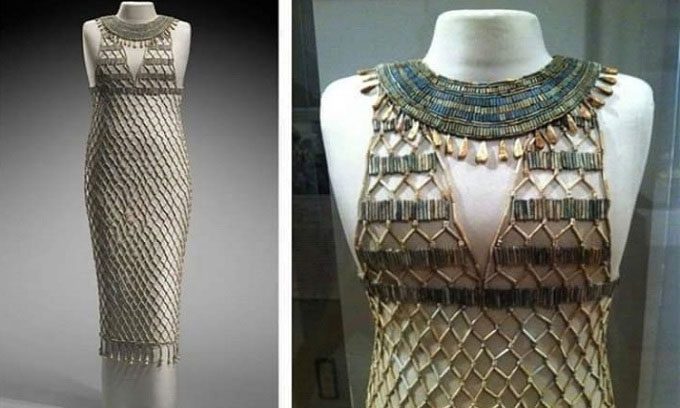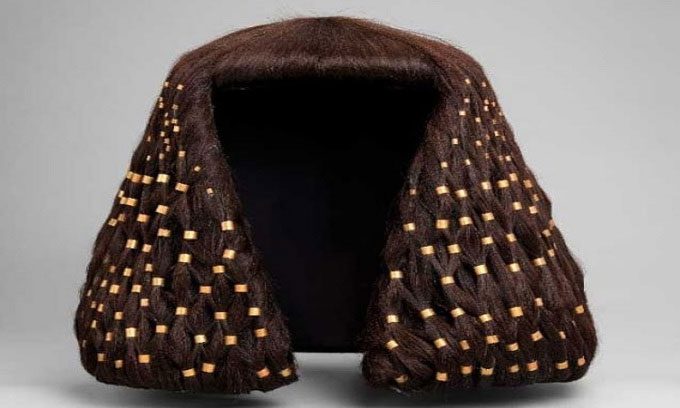Men and women in ancient Egypt wore clothing with similar styles and materials.

Beaded dress excavated from a tomb in Giza. (Image: World History)
Ancient Egyptians were capable of creating some of the most monumental and complex structures known to humanity, yet they wore remarkably simple clothing. The traditional garments of ancient Egyptians were made from locally available materials, and women often dressed similarly to men, as reported by Ancient Origin on July 26. However, there were exceptions, and the majority of the nobility in Egyptian society had styles that clearly reflected their status.
In the hot climate of Egypt, the clothing of the people was made from locally sourced cotton or linen. Some farmers also wore garments made from animal skins. The most common fabric was linen, derived from the abundant flax plants growing along the Nile River. This material was lightweight, breathable, and comfortable in hot weather.
In daily life, for the lower class Egyptians during the Early Dynastic Period (3150 – 2613 BC) and the Old Kingdom (2613 – 2181 BC), men and women wore similar clothing. Illustrations from this period show both genders dressed in long white dresses that reached the knees, secured with a belt. Some wore sandals woven from straw. Wealthy men also wore this attire but made from finer, lighter linen, while noblewomen wore slightly more elaborate garments.
Noblewomen in the Old Kingdom wore long, loose-fitting dresses that covered the chest, made from lightweight and expensive linen. They secured their dresses with straps over the shoulders and sometimes wore a lightweight hip covering on top. Additionally, they adorned themselves with dresses made from strings of beads.
Both men and women in ancient Egypt used cosmetics. They applied perfumes and scented oils, lined their eyes, and painted their faces. Naturally, the upper class could afford better quality products. Eyeliner was particularly popular. Egyptians used a pencil made from wood, ivory, or stone to apply kohl to their eyelids, enhancing the shape of their eyes.
Kohl was made from galena, a mineral found in the Sinai Mountains. Galena was then mixed with malachite and various other minerals, along with oil or fat, until it reached a paste or cream consistency. This kohl was quite expensive, thus only available to the upper class. However, poorer individuals had a substitute for kohl. Besides its cosmetic use, this powder also helped protect the eyes from infections caused by sunlight, dust, or flies. Malachite, in powdered form, was often applied under the eyes.

A wig found in the tomb of Sithathoryunet, daughter of a king from the 12th Dynasty of ancient Egypt. (Image: Met Museum)
Wigs and jewelry were also essential parts of ancient Egyptian attire, not only showcasing their wealth but also attracting the favor of the gods. Ancient Egyptians wore rings, earrings, bracelets, decorative buttons, necklaces, and pendants made from gold or precious stones. Lower-class individuals also wore jewelry made from colorful ceramic beads.
The design of jewelry in ancient Egypt often reflected religious themes. Motifs included symbols of gods and hieroglyphs as well as birds, animals, and insects. Common symbols included scarabs, the Eye of Ra, lotus flowers, papyrus, cobras, knots, the shen ring (symbolizing eternity), and the ankh (symbolizing life). Jewelry was often placed in tombs with the deceased so they could use it in the afterlife.
Egyptians wore wigs as they provided comfort in the arid climate and made personal hygiene easier while preventing lice infestations. Wigs were made from human hair until the Second Intermediate Period (1782 – 1570 BC) when horses were brought to Egypt. After that, both horsehair and human hair could be used for wigs. Wigs came in various styles for different occasions. Most wigs were long and heavy, carefully divided into curls or braids. Wealthy individuals often wore beaded wigs adorned with jewelry. Those who were poorer used wigs made from papyrus or shaved their heads and wore headscarves.





















































